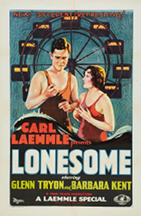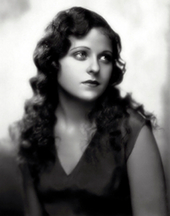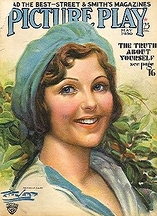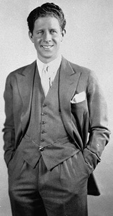Here are 10 things you should know Mary Pickford, born 131 years ago today. She was a true Hollywood pioneer with a list of career accomplishments that has rarely been equaled.
Tag: Charles “Buddy” Rogers
10 Things You Should Know About Charles “Buddy” Rogers
Here are 10 things you should know about musician and actor Charles “Buddy” Rogers, born 116 years ago today. We’ll be featuring his music all day today on Cladrite Radio, so why not tune in now?
Goodbye to another glorious gal: Barbara Kent
 Some years ago, we had the pleasure of viewing Lonesome, a silent-talkie hybrid that was released in 1928. It’s not an easy movie to catch; as far as we know, the George Eastman House in Rochester, New York, has one of the few extant prints. (Someone seems to have loaded Lonesome up on YouTube, and we suppose that’s better than not seeing it at all, but just barely.)
Some years ago, we had the pleasure of viewing Lonesome, a silent-talkie hybrid that was released in 1928. It’s not an easy movie to catch; as far as we know, the George Eastman House in Rochester, New York, has one of the few extant prints. (Someone seems to have loaded Lonesome up on YouTube, and we suppose that’s better than not seeing it at all, but just barely.)
Lonesome could not be more charming. Its appeal is based in large part on the fact that much of it was filmed on Coney Island, and any glimpse of that magical setting as it was in the 1920s is to be treasured.
But the plot of the picture is engaging, too. It tells the tale of two lonely Manhattanites who experience a chance meeting at Coney Island and go on to spend a magical day together before getting separated that evening, with neither having learned the other’s last name. In a city of millions, will they ever manage to find each other? (If you think we’re going to tell you how it turns out, you can think again. No blabbermouths, we.)
Lonesome was originally released as a silent picture, but with all the fuss over the new sound technology, it was decided to bring back all involved parties to film three scenes with synchronized music and dialogue. So it’s not quite a silent and not quite a talkie.
But it’s certainly delightful, in our opinion, and we encourage you, if you ever have the opportunity, to see it (in a theatre and not streaming online, if at all possible).
 But you might well be wondering why we’re mentioning what is today a rather obscure picture now? Well, we’re sad to report that it’s because the movie’s leading lady, Barbara Kent, one of Universal Studios’ original contract stars and the final surviving WAMPAS Baby Star of 1927, died a week ago yesterday at the age of 103.
But you might well be wondering why we’re mentioning what is today a rather obscure picture now? Well, we’re sad to report that it’s because the movie’s leading lady, Barbara Kent, one of Universal Studios’ original contract stars and the final surviving WAMPAS Baby Star of 1927, died a week ago yesterday at the age of 103.
The Canadian-born Kent (her birthname was Barbara Cloutman) was not, admittedly, the biggest of names, even at the height of her career, but she made her mark, making eight or nine silents before successfully navigating the switch to talking pictures. She made 25 sound movies following her appearance in Lonesome, but retired from acting in 1935.
Among Kent’s most notable films were her screen debut in Flesh and the Devil (1926), with John Gilbert and Greta Garbo; a pair of starring roles opposite Harold Lloyd, in 1929’s Welcome Danger and Feet First a year later; a supporting role in Indiscreet (1931), which starred Gloria Swanson; and Emma, which featured Myrna Loy and Marie Dressler.
 In the course of her nine-year career, Kent also worked alongside Douglas Fairbanks Jr., Richard Barthelmess, Edward G. Robinson, Charles “Buddy” Rogers, Andy Devine, James Gleason, Ben Lyon, Gilbert Roland, Noah Beery, Victor Jory, Dickie Moore, Monte Blue, Wallace Ford, Ward Bond, Arthur Lake, and Rex the Wonder Horse. That may not qualify as a Hall of Fame roster of co-stars, but many an actress has done worse.
In the course of her nine-year career, Kent also worked alongside Douglas Fairbanks Jr., Richard Barthelmess, Edward G. Robinson, Charles “Buddy” Rogers, Andy Devine, James Gleason, Ben Lyon, Gilbert Roland, Noah Beery, Victor Jory, Dickie Moore, Monte Blue, Wallace Ford, Ward Bond, Arthur Lake, and Rex the Wonder Horse. That may not qualify as a Hall of Fame roster of co-stars, but many an actress has done worse.
After retiring, Kent refused virtually all interviews about her years in Hollywood—one notable exception was the time she afforded author Michael G. Ankerich, who profiled Kent in The Sound of Silence: Conversations with 16 Film and Stage Personalities Who Bridged the Gap Between Silents and Talkies—as she settled into a successive pair of happy marriages—first to Harry Edington, a Hollywood agent, whom she wed in 1932, and then, some years after Edington’s death in 1949, she married Jack Monroe, a Lockheed engineer. Aside from evading would-be interviewers, Kent reportedly spent her free time in her golden years as a golfer and a pilot.
For more on Kent’s life and career, give this New York Times obit a look.
Fridays with Rudy: Vagabond Dreams Come True, Ch. 19
In Chapter 19 of his 1930 memoir, Vagabond Dreams Come True, Rudy Vallée addresses the question that’s had us all on the edge of our seats since the first chapter of the book: What type of woman is his dream girl?
THIS DREAM GIRL NONSENSE
 One ghost-written article entitled, “Wanted, the Girl of My Dreams,” did convey some of my ideas, but at best they were quite garbled—one part in particular that said I probably would not dare to meet any girl in her home and go to dinner because I feared that she would be ill at ease, feeling that she was with a musical celebrity. This resulted in hundreds of letters inviting me to home cooked meals and assuring me that the authors only wanted me for myself. I appreciate the sentiments of those who wrote me offering meals, and I wish I could have taken advantage of them, as I like nothing better than good, home cooking.
One ghost-written article entitled, “Wanted, the Girl of My Dreams,” did convey some of my ideas, but at best they were quite garbled—one part in particular that said I probably would not dare to meet any girl in her home and go to dinner because I feared that she would be ill at ease, feeling that she was with a musical celebrity. This resulted in hundreds of letters inviting me to home cooked meals and assuring me that the authors only wanted me for myself. I appreciate the sentiments of those who wrote me offering meals, and I wish I could have taken advantage of them, as I like nothing better than good, home cooking.Z is for Zelda
We don’t kid ourselves that our listeners and readers can subsist on Cladrite Radio alone.
Heck, no—after all, each of us occasionally finds ourselves without internet access, and what to do then, when you’ve got a yen to do a little reading about life as it was once lived?
Well, we know what we do—we reach for a copy of Zelda magazine, and our vintage itch is immediately scratched.

As is explained on the publication’s web site, Zelda is “inspired by days gone by and our goal is to share glorious tidbits of yesteryear while bringing you features on the best of what’s happening in the vintage-style culture today.”
We’ve read Zelda (heck, we’ve contributed to it), and the above sentiments aptly sum up what this winning biannual is all about. Take it from us, from interviews with the likes of Golden Era actress Marsha Hunt, former Zeigfeld girl Doris Eaton Travis, and Turner Classic Movies on-air host Robert Osborne to recipes (culinary and cocktail), fashion history and advice, music reviews, and so much more, Zelda’s got vintage culture covered from stem to stern.
 And just to show we’re willing to put our money where our mouth is, we’re going to offer the first giveaway we’ve ever undertaken at Cladrite Radio. The first six people to email us at zeldamag@cladriteradio.com will receive a copy of the current edition of Zelda (it’s issue #3, fyi), which boasts such fascinating features as a previously unpublished interview with the man once known as “America’s boyfriend,” actor, bandleader (and second husband to Mary Pickford) Charles “Buddy” Rogers; a profile of the once-best-selling (and not a little scandalous) but now largely forgotten author Ursula Parrott; an intoxicating drink recipe that updates the classic Manhattan cocktail while remaining true to the “spirit” of the original; a guide to the proper wearing of neckties; the sage advice of “Ask Mr. Burton”; and so much more (honestly, we’re just scratching the surface here).
And just to show we’re willing to put our money where our mouth is, we’re going to offer the first giveaway we’ve ever undertaken at Cladrite Radio. The first six people to email us at zeldamag@cladriteradio.com will receive a copy of the current edition of Zelda (it’s issue #3, fyi), which boasts such fascinating features as a previously unpublished interview with the man once known as “America’s boyfriend,” actor, bandleader (and second husband to Mary Pickford) Charles “Buddy” Rogers; a profile of the once-best-selling (and not a little scandalous) but now largely forgotten author Ursula Parrott; an intoxicating drink recipe that updates the classic Manhattan cocktail while remaining true to the “spirit” of the original; a guide to the proper wearing of neckties; the sage advice of “Ask Mr. Burton”; and so much more (honestly, we’re just scratching the surface here).
So drop us a line, being sure to include your name and mailing address, and if yours is one of the first six entries we receive, we’ll get a copy of Zelda right off to you.
Such a deal!
